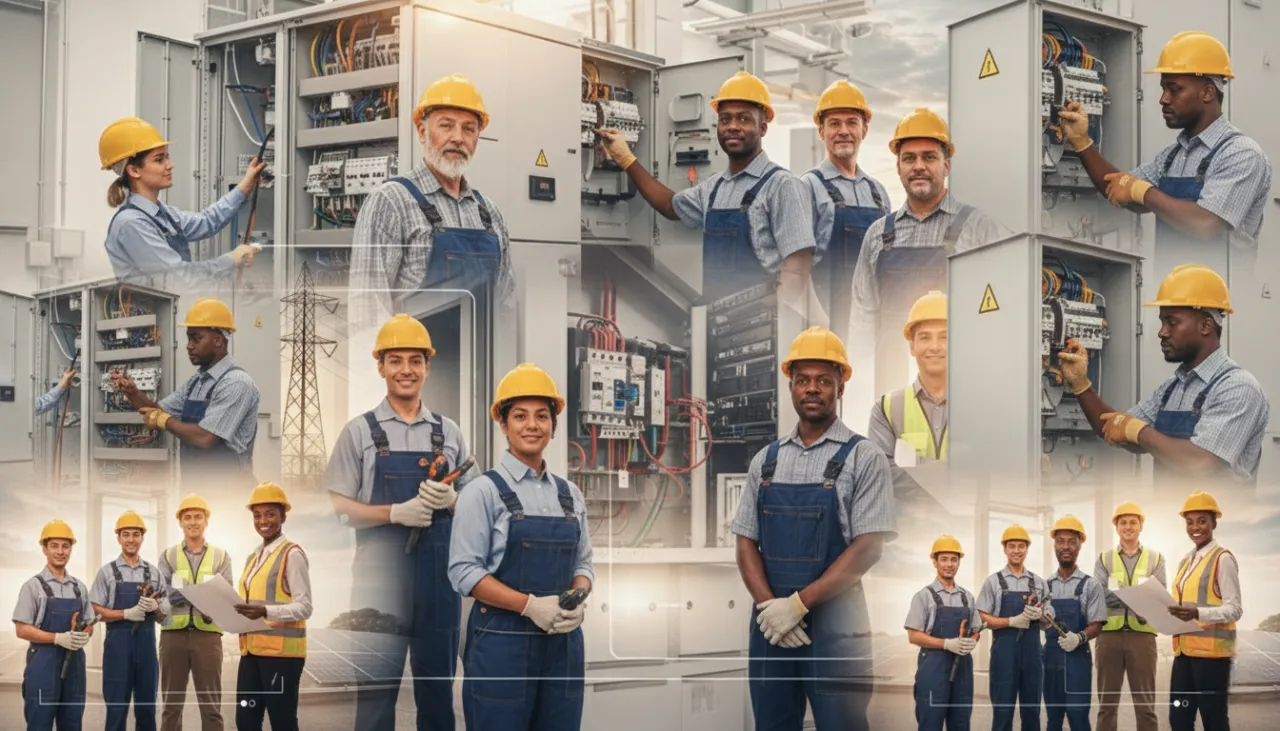Electrician Shortage 2025: America’s Power Grid Needs People, Not Robots
America is facing a new kind of energy crisis — and it’s not about fuel.
It’s about people.
Across the United States, a severe shortage of licensed electricians is threatening construction projects, renewable energy goals, and even the modernization of the national power grid. As AI and automation transform white-collar jobs, skilled trades like electrical work are booming, with more demand than available workers — and wages rising faster than ever.

A National Shortage Creating Delays and Opportunity
From housing projects in Texas to data centers in Virginia, employers are scrambling to find qualified electricians.
Industry reports show that the U.S. currently needs over 80,000 additional electricians just to meet active project demands — and that number is expected to grow 20% by 2030.
This shortage is hitting key sectors hard:
- Renewable energy expansion – solar and wind projects stalled due to lack of certified labor.
- EV charging infrastructure – slowed rollouts in major cities.
- Commercial construction – project delays and rising costs due to limited crews.
According to the National Electrical Contractors Association (NECA), nearly 40% of current electricians are nearing retirement age, while fewer young workers are entering the trade. The result: record job openings and rising paychecks.
High Pay and Job Security in an AI-Driven World
While many industries are cutting back due to automation, the electrician trade is thriving — precisely because robots can’t replace real electrical expertise.
This is one of the few careers that remain AI-proof, requiring human skill, critical thinking, and on-site precision.
In 2025, average electrician wages have jumped to $64,000 nationwide, with top-tier professionals in metro areas like Los Angeles, Chicago, and Dallas earning over $100,000.
Many union contractors now offer sign-on bonuses, relocation support, and paid apprenticeships to attract new workers.
“Every building, every data center, every EV station — they all need electricians,” says Michael Lacey, a senior labor analyst at the U.S. Department of Energy.
“Technology can design systems, but only people can power them.”
The Race to Train the Next Generation
To fill the gap, trade schools and unions across the U.S. are launching aggressive recruitment drives.
The International Brotherhood of Electrical Workers (IBEW) and various apprenticeship programs are partnering with high schools, veterans’ associations, and community colleges to train new entrants.
Most programs allow students to earn while they learn, combining classroom lessons with supervised fieldwork.
In some states, new fast-track certifications focus on solar installation, automation, and EV charging, helping workers get licensed faster and enter high-demand sectors immediately.
Educational institutions are also reframing the electrician path as a high-tech profession, not just manual labor.
Modern electricians work with:
- Smart grid systems
- Digital diagnostics
- Renewable energy storage
- AI-driven maintenance tools
This fusion of technology and trade makes the profession appealing to a younger, more tech-savvy generation.
Clean Energy Projects Driving Explosive Demand
The Biden Administration’s clean energy initiatives and infrastructure investments have supercharged demand for electrical labor.
Billions of dollars are flowing into EV charging networks, solar panel fields, and modernized transmission lines — and electricians are at the center of it all.
For example:
- California alone aims to add 250,000 EV chargers by 2030.
- Texas is building dozens of new renewable power facilities.
- New York is upgrading outdated grid systems to reduce outages.
Every one of these projects requires licensed electricians to design, install, and maintain systems — creating thousands of new jobs across the country.
The Human Side of a Digital Revolution
As AI reshapes white-collar industries, many professionals are reconsidering their careers.
Searches for “electrician training near me” and “electrician apprenticeship programs” have spiked 120% in 2025, according to Google Trends.
What’s driving this shift?
- Job security: Electricians are needed everywhere, from homes to factories.
- Physical presence: The work can’t be outsourced or automated.
- High impact: Electricians directly contribute to America’s modernization.
In short, while the digital world automates, electricians are the real-world problem solvers — the people who make innovation physically possible.
Hotspots: Where Electrician Jobs Are Exploding
Even smaller states like Iowa, Nebraska, and Alabama are seeing unprecedented hiring booms, offering relocation incentives for certified electricians.
A Career That Can’t Be Replaced
While many office jobs are at risk from AI, electricians are in the rare position of becoming more valuable over time.
Each advancement in technology — from renewable systems to digital controls — requires human oversight, installation, and maintenance.
This reality is drawing a new wave of career changers: tech workers, engineers, and even former corporate employees who want a tangible, stable profession.
“There’s something powerful about doing work that matters — work that you can see and touch,” says Lacey. “Electricians literally keep America running.”
The Bottom Line: America Needs Electricians Now
In 2025, the electrician career isn’t just a job — it’s a national priority. From powering cities to building a cleaner future, electricians are shaping the foundation of America’s next century. With rising pay, unmatched job security, and modern technology transforming the field, this is more than a trade — it’s a mission.











